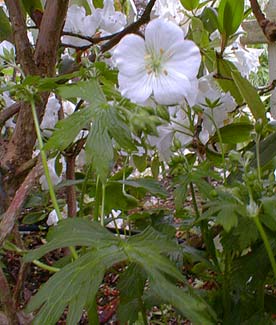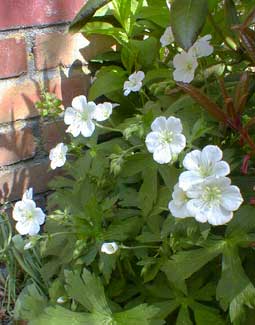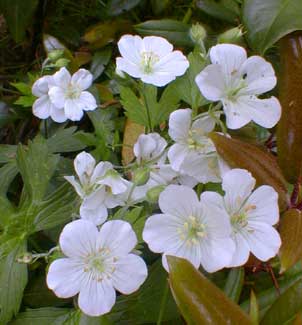
Wild
White
Geranium
"The wild geranium holds its dew
Long in the boulder's shade."
-William Vaughn Moody
(1869-1910)
(1869-1910)
I love this snowy-white native wildflower (Geranium maculatum variant album). It is a wonderful addition to any collection of crane's-bills, most of which are pink, blue, or violet, many of which can be a little too similar at times, so that white stands out among them all.
Unlike many crane's-bills, this bright white one is very unforgiving of droughty conditions. But given persistantly moist rich loam, it will flower extravagantly.
 The leaves are beginning to reappear in February from its died-back clump, & it is in full bloom by April & in fullest flower for May.
The leaves are beginning to reappear in February from its died-back clump, & it is in full bloom by April & in fullest flower for May.It sometimes but not reliably continues to flower throughout the majority of summer summer. If it experiences a droughty patch at high summer, it will stop blooming by the end of June, &mp never blooms beyond August. It does not need deadheading, because it is not apt to extend bloom into autumn in any case.
Originally this was planted att he dripline of the Loder's White Rhododendron, but the small white flowers of the crane's-bill were completely lost when blooming simultaneously with the Loder's White. It was getting too much shade besides, so there were two reasons to move it.
It was transplanted to the bottom of the front porch staircase at the drip-line of the Hill's Bright Red Rhododendron, where it showed itself to far greater effect. It spills out onto the sidewalk from the dripline of the rhody.
It does well enough in full sun, but it's ideal is rich moist soil in a mix of partial shade & partial sun. It is forgiving of a wide array of soil & lighting conditions, but will not bloom well in deep shade.
This wild geranium is from the midwest & the northeast of America, or the entire right-hand half of the US & Canada. The white variant is native of Missouri, so it naturalizes well in cold & temperate climates.
 It may self-seed more than desired, but young plants are easily pulled in the course of one's usual weeding, or transplanted to pots to give as gifts.
It may self-seed more than desired, but young plants are easily pulled in the course of one's usual weeding, or transplanted to pots to give as gifts.It is not subject to much in the way of disease or insect attack. It mounds to two feet tall & if planted under a shrub as is ours, it can climb upward through branches to an even greater height.
The species & its white variant are often called "Spotted Hardy Geranium," because the big dark-green weed-smothering leaves have a faint, pale green speckling over dark green deeply cut leaves. The leaves are gorgeous enough to sustain autumn interest even when the clump is not blooming.
Spotted Crane's-bill was once regarded as a medicinal plant for the astringent properties of the root, being so rich in tannins it was even used for tanning hides. The first whites in North America learned about many of its uses from native peoples. It was regarded as mild enough (because flavorless) for use especially for young children or the elderly.
The roots were dug up just as clumps began to flower. These were dried & kept as part of the home medicine arsenal. It was brewed as a tonic to treat everything from diarrhea to venerial or kidney disease to cholera; used as a gargle to treat thrush or other mouth infections; as a douche for vaginal discharge; & topically for infected wounds & hemorrhoids.
Due to its wide distribution & its household uses, G. maculatum acquired a number of regional folk-names. Because it was used medicinally for "women's complaints" it was called Shameface or Fluxweed. It was called Alum Root Flower because its roots shared the astringent qualities of species of true alum root, such as Heuchera americana. For the same reason it was called American Tormintill in imitation Potentilla tormentilla the root of which was likewise used medicinally. It was sometimes Culver Root because another native plant with that name, Veronicastrum virginicum, had roots with similar uses. It was called Sailor's Knot or Love Knot because of the root's appearance.
It was called Red Robin not because it is red (though regional color variations include a nearly red-flowered strain) but because it bloomed when the robins returned in spring, for the same reason trilliums are known as wakerobins. The name Old Maid's Nightcap alluded not to the flower as hat-like, but to its use by the elderly as a sleep aid. Other of its names, some shared with other native crane's-bill species, include Storkbill, Chocolate Flower, American Kimo Root, or Rock Weed. Dove's-foot, Crow's-foot, Pigeon's-foot evoked the shape of the leaves.